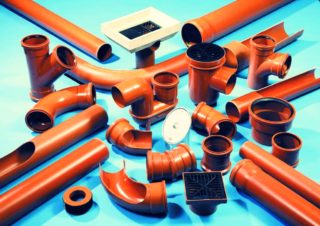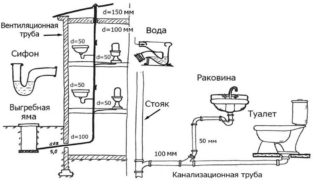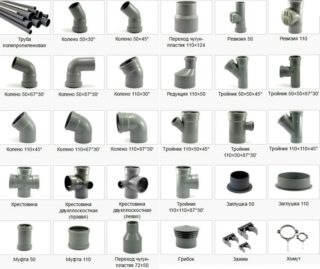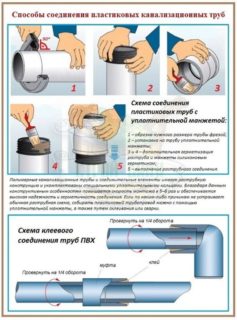For the installation of the sewer network, pipes and fittings are required - accessories. The correct choice of these parts determines the efficiency and duration of the system.
Manufacturing materials

Sewerage pipelines are made of cast iron, polyethylene, polypropylene, polyvinyl chloride, steel, asbestos cement and ceramics. Component elements are selected from the material that was used for the manufacture of pipe sections.
Most often, polypropylene, polyethylene and PVC elements are chosen. They are less durable than metal ones, but they have the following properties:
- incombustibility;
- resistance to the influence of external factors;
- resistance to corrosion;
- resistance to aggressive chemicals.
Plastic parts do not react with acids and alkalis. Affordable price is also an advantage.
The second most popular is ductile iron. It can withstand any stress and, unlike other ferrous metals, does not rust. But such pipes weigh a lot, which complicates installation, and are prone to silting. They are more often installed in enterprises where the issue of the strength of the line under high load is important. Pipelines made of other materials are rarely installed.
If the sewage system is of a forced type, it is important to choose the pressure head elements of the line. They are also made of plastic or cast iron, but they are designed for higher pressure, because the possibility of a breakthrough must be completely excluded.
Varieties of component parts
Other elements for internal sewerage may be needed:
- Reduction - for transition between sewer pipes of various cross-sections, as well as for joining cast iron and plastic products.
- Two-plane cross - to make two elbows at right angles to pipe sections with the same or different sections, the angles of inclination are 45 and 90 degrees.
- Single-plane cross - for the device of two parallel branches with angles of 45 and 90.
- Elbow - when creating bends in the laying of two parallel pipelines, angles of 30, 40 and 90 degrees.
- Compensation pipe - to eliminate damage by replacing the problem section of the line, which is cut out in advance.
- Cap - an element that blocks the transported drains when performing repairs or revisions.
An aerator or sewer valve is used to block the escape of gases into the bathroom through the toilet as a result of the rarefaction of air inside the drain pipe, which causes the water seal to be pulled out of the siphon device. Mounted on the top riser end.
A non-return valve is used to install an external sewage system. It is used to block the reverse flow of the circulating fluid and must be installed on pipelines laid with an inclination of less than 2 cm. A two-knee siphon is also required, which combines two parallel pipe sections.The created bend at the junction prevents the backflow of sewage gases.
Sewer Fittings Dimensions
To lay the internal sewage system, you will need pipes of the following sizes (sections):
- shower, sink, bidet, sink, bathtub - 40 mm;
- combined drain for shower, bath and sink - 50 mm section;
- toilet bowl and central riser - 110 mm;
- branches from the main riser - 60 mm.
For the installation of external communications, pipe sections with a cross section of 160-200 mm are used. The dimensions of the plastic drain pipes and the corresponding fittings must match. According to GOST, couplings are usually produced with a section of 110–400 mm and a length of 120–330 mm. The standard diameter of the elbows is 110–400 mm, the distance between the sockets is 15–90 mm. Tees at 45 degrees are made with a cross section of 110–400 mm, the length of the side sockets is 140–530 mm, and the height from the end part to the beginning of the projection of the funnel is 140–500 mm. The cross-section of the return valves is 110–250 mm, the double-knee siphons are 110–200 mm, the length is from 300 to 520 mm and from 510 to 820 mm, respectively.
Recommendations for the selection of pipes and fittings

For reliable, durable and safe operation of the sewage system, the following recommendations are followed:
- Before purchasing pipe sections and fittings, draw up a project indicating all drain points and plumbing fixtures. It will help you navigate what section and length pipes are needed and how many components are required. The latter figure will depend on the number of turns and forks.
- Add a 10% margin to the calculated pipe length.
- If possible, complete the line with fittings from the same manufacturer as the pipe sections. Acquire parts with an exact match in size.
- Select the pipes for indoor and outdoor pipelines of the appropriate size so that too much pressure of the sewer does not lead to a pipeline rupture.
The more fittings in the pipeline, the higher the likelihood of blockages. Simplify the geometry of the drainage system as much as possible, and place the sockets so as to ensure a free outflow of water.
Installation features
- Large plastic parts are cut using a special tool - a pipe cutter. Instead, you can use a grinder or a hacksaw.
- The cut is performed at right angles to the pipe axis, since it will not be possible to make a tight connection if there is a skew at the junction.
- The ends of the pipe sections to be joined are made as straight as possible. The edge of the saw cut is processed with sandpaper or a file.
- The joints of the glued fitting elements are pre-degreased, then glue is spread and the parts are connected. The protruding glue is removed with a rag. Using fittings with a sealant, the surface of the joints is coated with silicone sealant.
- Parts are inserted not all the way, but with a distance of 1 cm to create an expansion gap. To do this, it is necessary to make preliminary measurements and put a mark on the pipe section to limit the depth of entry.
Avoid 90-degree joints, it is better to replace one elbow at a right angle with two of 45.
The price of pipe sections and fitting elements depends on the material, purpose and manufacturer. For example, pipe sections with a cross section of 50 mm and a length of 500 mm made of polypropylene from the Sinikon company are sold at a price of 63 rubles. The same part of the "Politron" brand can be bought for 41 rubles. A Hemkor pipe with the same dimensions, but made of PVC-U, costs from 34 rubles.










